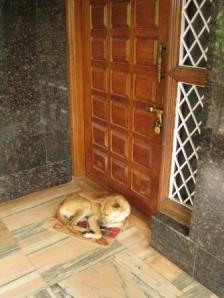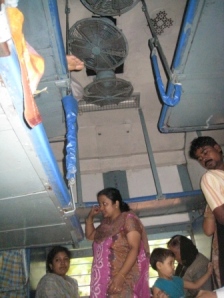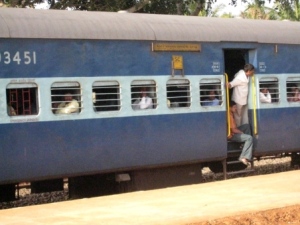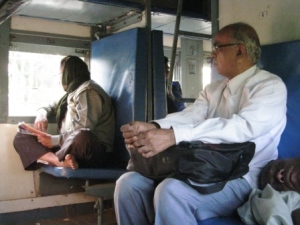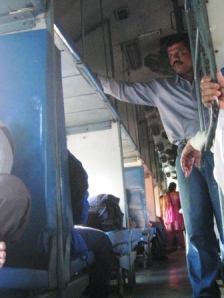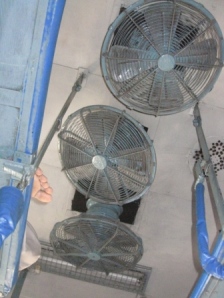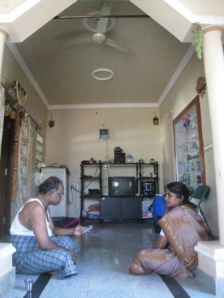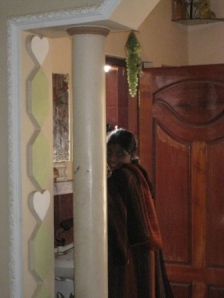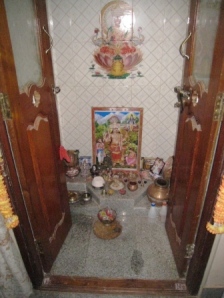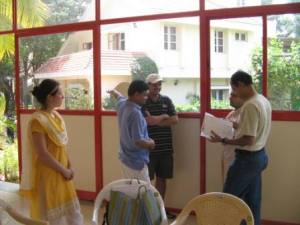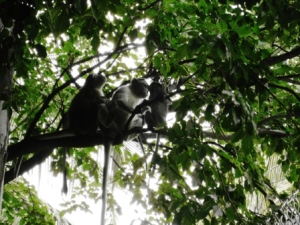The following day, Kulkarni did the unthinkable: took the day off so that he and his whole family could take me to Mysore, a famous city once ruled by the powerful Wodeyar dynasty that has a pretty crazy palace. It’s about 3 hours from Bangalore by car…
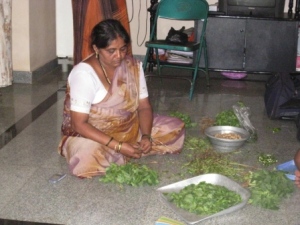
Kulkarni's wife, preparing food.
The day began at 4am, when the women on the house woke up to start preparing our meal. I mean our lunch/dinner—they cooked everything, down to rolling out and baking chapatti (the bread) then packed it in a number of tins to take with us. Even though I was not participating in these preparations, they’re pretty hard to sleep through. (Especially when the preparations are going on in the same room.)
Then, of course, came the getting ready. It had been agreed the night before that both Vidya and I would wear saris on our big day out. Kulkarni’s wife always wears one, but the two youngest don’t really wear them at all. I had brought one of my saris from home in case I needed it (I do like wearing saris) and the women of the house had great fun in wrapping me and then applying all the necessary accessories, such as a necklace and earrings. They also stuck a bindi (the dot thing, often a fun sparkly piece of bling) between my eyebrows and then also applied dots of some kind of colored paint just below and above the bindi.
I felt bad that Kulkarni, while appreciative of me in a sari, was extremely vocal about his less approving opinions of Vidya in a sari: “Sari does not suit her. She is too big. You are slender. You can wear it.”
Tact doesn’t seem to be part of the Indian consciousness: In the same way that Kulkarni is loudly critical of one daughter’s appearance, he also loudly tells me that the middle daughter is his “slow” daughter (not at the same moment). So I guess that each daughter gets their share of the criticism…
We had arranged the day before to rent a car with driver, and the car was supposed to arrive at 7am. Of course it didn’t arrive until 8am. Although Kulkarni was anxious to get on the road, we had to wait while the ladies of the house performed a pooja on the car—a blessing to ensure our safe passage. A garland was procured from a passing flower seller—as were strings of jasmine flowers for our hair—which was affixed to the front of the car. Incense was waved in front of it before being installed on the dashboard of the car where it continued to burn. Finally, we piled in and were off.
Packed into a car with an Indian family, tons of food, incense burning and Indian music blaring. 8am. The day was young.
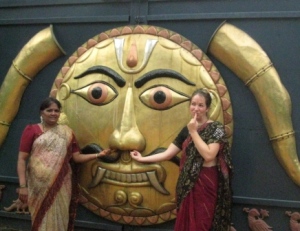
The gate of the Folk Arts Museum that was closed next to the place where we ate breakfast on the road to Mysore.
The first amusing thing happened around 10:30am when we stopped for a bathroom break sometime after we’d stopped for breakfast as well as souvenir shopping along the road to Mysore: my boss offered me a beer.
I need to back up here to explain that in a conversation with my Program Manager, Laxmi, Kulkarni had overheard me asking her if my landlord had a problem with alcohol (some do). Laxmi answered, “No,” while Kulkarni started laughing.
“Why does it matter if they allow alcohol or not?” he scoffed. “Women don’t drink!”
I responded that, actually, women DO drink in the US, and that it’s very common and accepted. I guess he remembered that conversation, although we never discussed specific alcohol or mentioned it again, because Night One at his home he gave me a can of Kingfisher beer and had one himself. It was funny because he was obviously NOT in the habit of drinking and admitted as much when I asked him. He looked fairly awkward and burped uncomfortably. I was only drinking to humor him since he’d gone out of his way to be nice to his guest.  The next night, when he asked if I wanted one (he was going to send one of his errand boys for it), I declined. He didn’t force me this time, but made sure I knew that if I wanted one, to let him know and he would send one of the boys for me.
The next night, when he asked if I wanted one (he was going to send one of his errand boys for it), I declined. He didn’t force me this time, but made sure I knew that if I wanted one, to let him know and he would send one of the boys for me.
So back to the road to Mysore. 10:30am. I guess they needed change for a larger bill, and the place we happened to stop in front of was a bar. He didn’t say anything to me as he was making purchases to get change, but after we had set off in the car again he turns around from the front seat and passes beers to me and Manjunath (Vidya’s husband). I protest that it’s too early for beer (much less a warm one) but he insists I take it. So I do, leaving it in the seat pocket in front of me. This is a far cry from the vodka I was forced to consume in Uzbekistan for sure, but some techniques (accepting the offered beverage but avoiding drinking it) are universal.
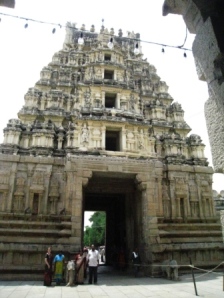
On the backside of the entrance building into the temple.
Our first stop was slightly outside Mysore, in a place called Sri Rangapatnam. This was the base where one Muslim king/sultan and then his son ruled much of southern India during the 18th century, until the British came through in 1799. It’s known for having some cool Muslim mausoleums as well as the above king’s summer palace, but we only went to the famous Sri Ranganathaswamy Temple before moving on. Outside the temple were a number of souvenir booths with very determined sellers. Much of the stuff was the same as the place where we had stopped on the road, but it was all cheaper. This made Kulkarni angry, since we’d all made purchases elsewhere. I had assumed he would know if I was getting a fair price or not, but I had assumed wrong.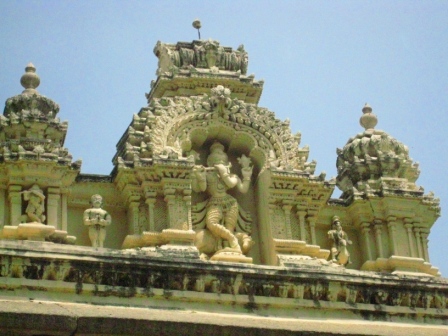
It was funny to watch the family interact as a family—just like a stereotypical family on a road trip. The mother and kids want to shop and buy trinkets and food while the father laments how much everything costs. The oldest daughter and her husband (in the American version, it would be boyfriend) aren’t into seeing the temple and prefer to wander off by themselves, happy in their couple-dom.
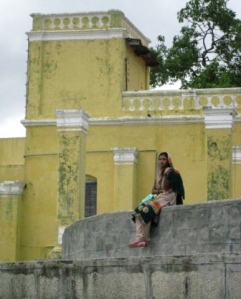
Behind the temple.
From there we went up to Chamundi Hill,
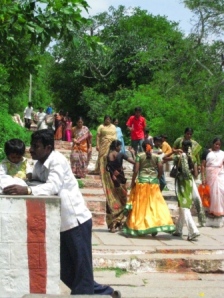
The steps.
which has another famous temple, Sri Chamundeswari, and views of Mysore. The line to go through was fairly long, but Kulkarni and his wife humored me and we went through it. Pilgrims are supposed to walk up and down the 1000+ steps to get there; I guess I’ll have to come back to have the experience (and workout). Halfway along those steps, though, is a 5m high “Nandi” (a.k.a. bull, which is the god Shiva’s transport) that was carved from solid rock in 1659. It’s one of the biggest in India and was pretty cool to check out (and take photos).

Nandi and me.
We descended into Mysore and made a beeline for the Maharaja’s Palace. The palace and its grounds are pretty grand, though I remember the ones I saw in Rajasthan as being even more so.
Kulkarni had to go to a ticket booth to purchase entrance tickets, which were 20 Rupees for Indians and 100 Rupees (roughly $2) for foreigners. I told Kulkarni that I would go to the counter and purchase my own ticket; he’d already gone through considerable expense to show me Mysore and he didn’t need to pay my “foreigner” price. He refused to listen to me. After purchasing the tickets, he told me and Vidya that he had insisted the ticket seller give me the Indian price:
“She’s part of my family,” he told them. “She’s with an Indian family, she speaks Kannada and she’s wearing a sari! She is Indian.”
What is amazing about this exchange is that it actually worked, and Kulkarni didn’t have to fork out the extra cash for a foreigner ticket.
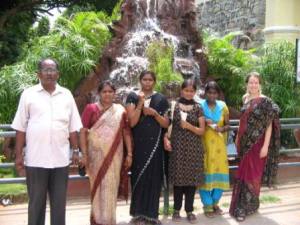
Me and my Indian family.
However, even though you’ve bought your ticket to enter the palace grounds, you have to show it again to actually enter the palace. Kulkarni was ahead of the group and the ticket collector refused to let me pass with an Indian entrance ticket. Vidya frantically explained the situation (there was a growing crowd behind us; we were holding up the line), but the man seemed unflappable.
Unflappable, that is, until I greeted him and introduced myself in Kannada (with the customary hand gestures): “Namaskara. Nanna hesaru Lesley.” He looked at me, shocked, and waved us through, to the giggling delight of Vidya and myself.
The original palace burnt down and the current one was designed by a Brit in the early 1900’s. You can see the British influence in the crazy stained glass. And gaudy, over-the-top is the name of the game when it comes to India as a rule. I was walking slowly through the rooms (as were many of the Kullkarni family), to the irritation of Kulkarni himself.
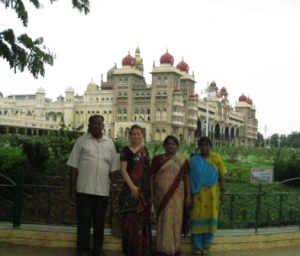
In front of the Palace.
The disadvantage of traveling with people who have been somewhere before is that they can move through it much more quickly and seem more interested in getting to the next destination than in viewing what’s before them. And I will say that Indians, from my personal experience thus far, are marathon tourists (remember not coming from touring rainwater harvesting systems in villages until after 11pm??), and the family was anxious to show me everything. It doesn’t bother me so much, as I know I’ll be coming back sometime to do things my style…
From there we left Mysore and pushed on to what the Indians call KRS Dam, which is known as Brindavan Gardens in the guidebooks. This popular, beautiful expanse of gardens and fountains is a popular place for shooting Bollywood scenes.
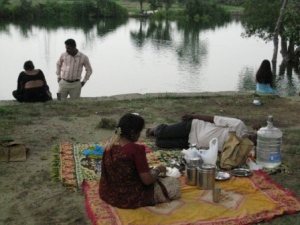
Relaxing after lunch/dinner.
As it was 4pm by the time we approached, we stopped somewhere outside the entrance near a small dam to eat the large picnic meal that had been prepared 12 hours beforehand. (Once again I was handed a beer, which I drank this time.) After eating, the family chilled for a few minutes and I wandered through an empty temple. Then the family decided it was time to go swimming, since we were next to a dam.
Now, none of
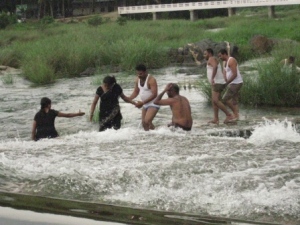
Niwiditha and Manjunath helping Vidya, with other Indian guys enjoying the water. ( Yes, that is the traditional Indian version of a men's bathing costume.)
us had actually brought swimming clothes, or even clothes to change into after swimming. This didn’t bother any of the Kulkarni family, except Sunita. I, however, was not about to risk damaging my sari, much less be the white girl in the water with all the Indian guys who were already enjoying it. In addition, the people in my group who work on health issues are always talking about all the giardia and other scary infectious bacteria that congregate in such public swimming areas… Lastly, I figured I should try not to cross the line between personal and professional. I was with my boss, after all.

Sunita and me in the coracle.
My boss had no such reservations. He immediately stripped down to his underwear, and we’re not talking boxers. He and the family went into the water (more like walked along the shelf of water) while a boatman took Sunita and I for a spin in this raft of sorts called a coracle, which was pretty cool (and good for catching shots of the others).
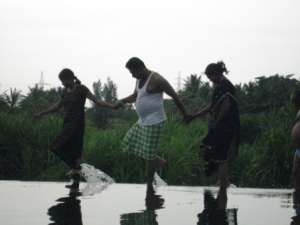
Niwiditha, Manjunath and Vidya.
The rain started just as the family was getting out of the water. They tried to dry out as best they could before we all piled back into the car to reach the real KRS Dam. The drive still took a bunch of time and we had to pay numerous tolls to get there, bordering on ridiculous. Once we actually got there, the rain had stopped, but most of the family was too tired to go beyond the parking lot.
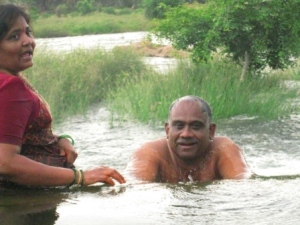
Probably the only picture in existence with Kulkarni smiling.
Kulkarni and I went in ourselves. (I felt bad about this – clearly we had only gone through the trouble of coming here so that I could see it – but there wasn’t much I could do beyond go see what they had brought me there to see.) The gardens were gorgeous and we stopped in lots of places to take pictures—mostly Kulkarni having me go stand somewhere and taking a picture of me with my camera.
I need to return here to the fact that I was traveling with an Indian family while wearing a sari. I knew from the wedding experience that people get really excited about seeing a white person in a sari, but I had underestimated the reaction. Most places we went that day, I gave the legit tourist sites a run for their money in regards to attention. Several people came forward to tell me things like, “You are looking very well in sari.” On the “photo shoot” at KRS, every time Kulkarni had me go pose somewhere, a crowd would gather to watch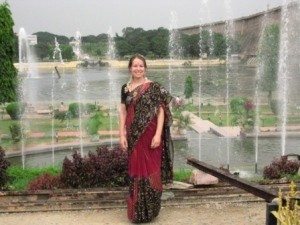 me. One girl around my age was so dumbfounded she insisted her husband photograph us together with her cell phone. Families came forward to shake my hand and ask me multiple questions about what I was doing. Some of the people who approached me were from other states, which was a problem as Kulkarni doesn’t speak Hindi and most of them didn’t speak English.
me. One girl around my age was so dumbfounded she insisted her husband photograph us together with her cell phone. Families came forward to shake my hand and ask me multiple questions about what I was doing. Some of the people who approached me were from other states, which was a problem as Kulkarni doesn’t speak Hindi and most of them didn’t speak English.
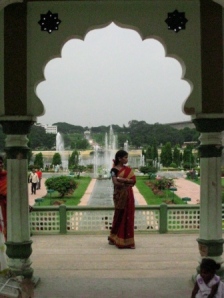
I may be partly Indian, but the full Indians can still pull it off better than I can.
We decided to skip the light and music show that goes down at the main fountain at 7pm to rejoin the others and begin the trip home. Kulkarni was very pleased at how I turned out in a sari. “You are not fully American,” he told me, “You are at least part Indian.”
As we began our return to the parking lot, I commented to Kulkarni on how beautiful the park was, and he agreed. He smiled a knowing smile and said the gardens were very popular, especially with newlyweds. I reflected on this for awhile…
The thing is, here, when people are married, it is the first time they are allowed to visibly be a part of a couple and engage in any kind of PDA. So, even though most of the marriages here are arranged and the couple don’t interact very often before the wedding, they all get into the fact that they can BE a couple, walk around holding hands, pose in pictures with their arms around each other, etc.
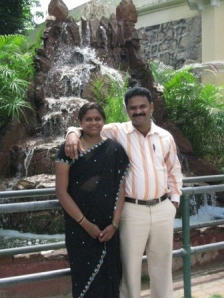
Vidya and Manjunath
Vidya and her husband, Manjunath, are good examples of this phenomenon. Married in April—an arranged marriage—I was initially rather impressed by how much they seemed to be into each other. Because, of course, coming from a culture that isn’t into arranged marriages, I assumed that they’re awful and not fulfilling and the couple can’t possibly be compatible. Seemed to me that their happiness was a stroke of luck.
But as I’ve watched people here and also talked about it with others, I think it’s just one of those things that’s just different from how we work. Our attitude is that you establish your relationship and love and confirm it by getting married and raising a family. In India, you get married and BUILD your relationship and love through sharing a life and raising a family. That’s not saying that all marriages are a success here, just like at home, and ways out of a bad one in India are, by and large, much more difficult. Divorcees have awful stigmas attached to them, for example.
But for most of the culture to begin choosing their mates, more than just the attitude about marriage would have to change: girls would have to be able to have more social freedoms to go out and actually interact with guys, for one. While this is less an issue in the more urban and educated areas, you’re unlikely to find these norms shifting in the villages any time soon.
Chachadi’s daughter, who is year younger than me, married for love not too long ago. She approached her father and told him, “I know you’re probably looking to find a husband for me soon, and if you’re going to be doing that, I’d like you to consider this guy.” It took numerous meetings between the parents on both sides to agree, but it happened.
On the other side of the coin, Naveen, the guy who runs the Deshpande office in Hubli (he also happens to be Taryn’s boss and is probably in his early-to-mid 30s), recently told me that he married for love in 2004. He added that he and Neelam (who we’ve all met) had been living together since 2001, which is pretty unusual. But, unlike Chachadi, neither set of parents was happy with this behavior. It sounds as though Neelam’s parents have started to warm up to it in the past year or so, though they’re still uncomfortable with inviting Naveen to family events. His parents, on the other hand, are still obstinately angry about the whole thing.
So after the tour of KRS Dam, we began the trek home. By then it was extremely dark out and the rain began to pour incessantly. The car would quickly fog up, so we had to keep some of the windows cracked. And the windshield windows seemed to have problems functioning. I felt awful for the driver—I certainly wouldn’t have wanted to have been driving under the conditions. One by one we all nodded off.
I woke up as we were getting closer, and I had a minor feeling of panic when I realized how fast the driver was going. All drivers go fast here. But I was also unnerved by the rain—still pouring down—and the idea that it was late and dark and we’d all been up ALL day, and that I was the only one awake. I was afraid that the driver would himself fall asleep in the silence and lose control of the car. Perhaps too much paranoia on my part, but we were going super fast in awful rain, and even if you trust the driver you have, there’s no accounting for the other crazies on the road. And there’s a distinct lack of road rules here (or at least a lack of adherence to them if they exist). So I spent the last 40 minutes of the ride home in panicked terror.
But we made it.

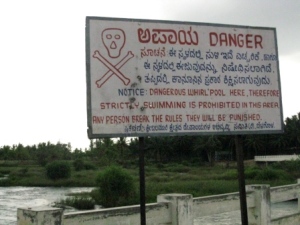
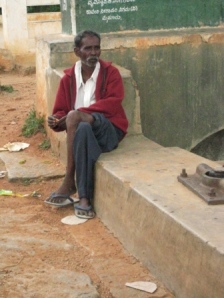
Lifeguard?
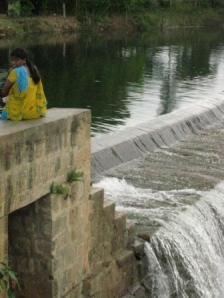
Sunita.
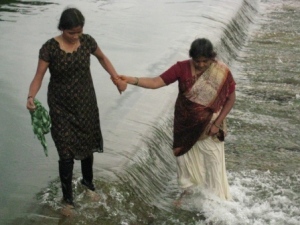
Niwiditha and mother.
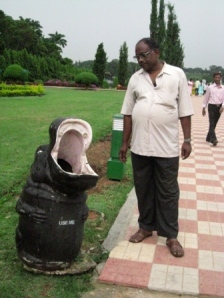
Kulkarni humoring me by standing hear a hippo trashcan.









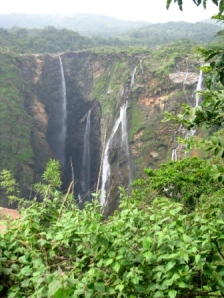
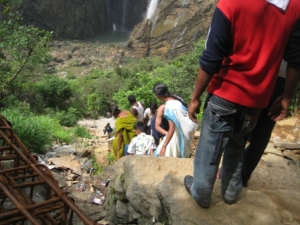
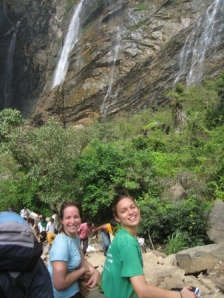
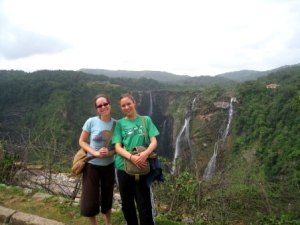
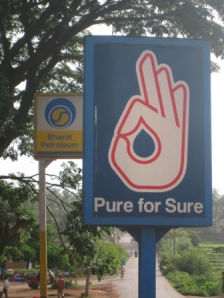
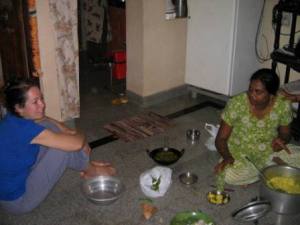
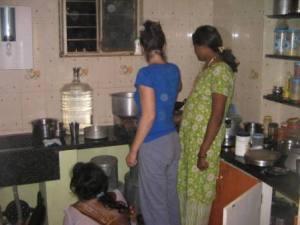
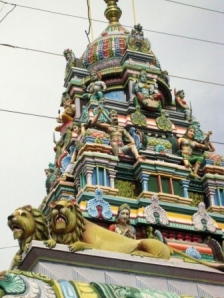
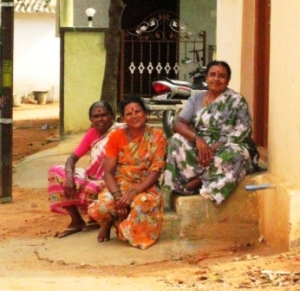
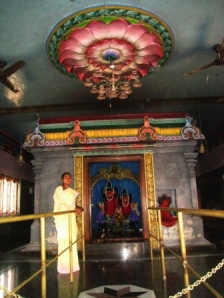
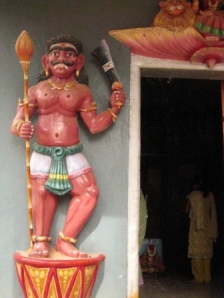
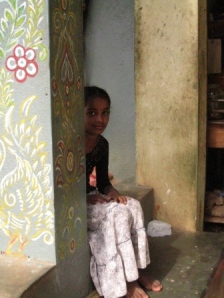
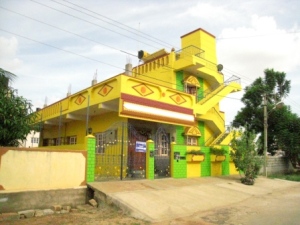
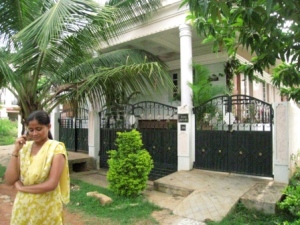
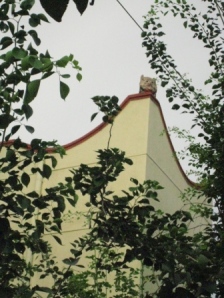
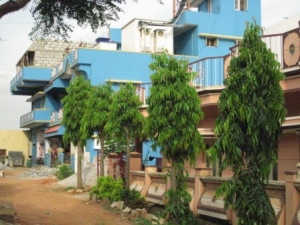

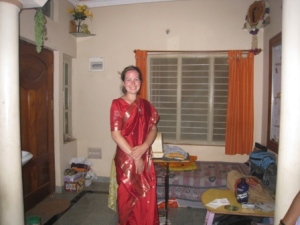
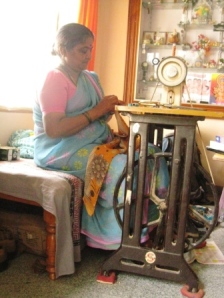
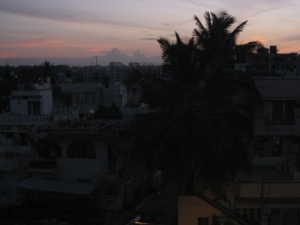


 The next night, when he asked if I wanted one (he was going to send one of his errand boys for it), I declined.
The next night, when he asked if I wanted one (he was going to send one of his errand boys for it), I declined.











 me.
me.







